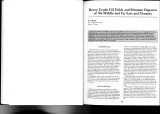TO
| Title | Date | Subject | Description | ||
|---|---|---|---|---|---|
| 1 |
 |
Association of uranium and other metals with crude oil, asphalt, and petroliferous rock | 1954-10 | uranium; crude oil; asphalt; petroliferous rock | Some crude oil, natural asphalt, and petroliferous rock are appreciably radioactive, but little is known about the actual uranium content and the chemical nature of the uranium compound or compounds in these materials. Semiquantitative spectrographic analyses of the ash of 29 samples of crude oil, 2... |
| 2 |
 |
Green River Formation at Raven Ridge, Uintah County, Utah | 1965-07 | Green River formation; Raven Ridge; sandstone beds; shale; limestone; marlstone; oil-bearing strata | Along Raven Ridge in Uintah County, Utah, exposures of the Green River Formation contain a complex sequence of intertonguing beds of sandstone, shale, limestone, and marlstone. These strata are considered to represent deposition in an orderly sequence of environments from the flood plain through the... |
| 3 |
 |
Petroleum geology of the greater Red Wash Area, Uintah County, Utah | 1965-07 | oil and gas field; sandstone; petroleum geology | The Greater Red Wash area is the largest oil and gas field in the Uinta Basin. The Douglas Creek and Garden Gulch Members of the Green River Formation form a lacustrine delta in the area and yield hydrocarbons from a complex network of discrete sandstones. Each individual sandstone body forms its ow... |
| 4 |
 |
Geology of the Mill Fork Area, Utah | 1972-12 | geology; Mill Fork area; geologic structure; Green River formation | The Mill Fork area comprises about 70 square miles of Cretaceous ( ? ) and Tertiary sediments at the northern end of the Wasatch Plateau in Utah County, Utah. Over 9000 feet of nonmarine sediments are present and belong to the North Horn, Flagstaff, and Green River formations. These sediments record... |
| 5 |
 |
Field experiment of in-situ oil recovery from a Utah tar sand by reverse combustion | 1976 | in-situ oil recovery; Utah tar sand; reverse combustion; oil recovery | Part of the mission of the Energy Research and Development Administration (ERDA) is to develop all energy sources to meet the needs of present and future generations. Toward that mission the Laramie Energy Research Center (LERC) is conducting research and field experiments for the development of rec... |
| 6 |
 |
Field guide to lacustrine and related nonmarine depositional environments in tertiary rocks, Uinta Basin, Utah | 1976-11 | lacustrine environments; nonmarine depositional environments; tertiary rocks | The lower part of the Tertiary System in the Uinta Basin of northeastern Utah and northwestern Colorado (fig. 1) reflects a series of very complex and variable forms of continental sedimentation in a basin of internal drainage. These complex forms represent the disruption of the Cretaceous depositio... |
| 7 |
 |
Petroliferous lithosomes in the Moenkopi Formation, southern Utah | 1977 | petroleum; stratigraphic study; southeastern and central Utah petroleum; Moenkopi Formation | Recent stratigraphic studies of the Triassic Moenkopi Formation suggest the possibility of important petroleum potential within the unit in southeastern and central Utah. Potential reservoir rocks include shoreline sandstone in the Black Dragon Member, carbonates in the Sinbad Limestone Member, and ... |
| 8 |
 |
Oil impregnated carbonate rocks of the Timpoweap Member Moenkopi Formation, Hurricane Cliffs area, Utah and Arizona | 1979 | Oil impregnated rocks; Hurricane Cliffs; Utah; Arizona; Timpoweap Member; Triassic Moenkopi Formation; Timpoweap Canyon; Hurricane, Utah | Oil impregnated rocks crop out at several localities near the Hurricane Cliffs in southwestern Utah and adjacent Arizona. The most significant petroliferous deposits occur in the Timpoweap Member of the Triassic Moenkopi Formation in Timpoweap Canyon and the Hurricane Cliffs south of Hurricane, Utah... |
| 9 |
 |
An echoing in-situ combustion oil recovery project in a Utah tar sand | 1982 | in-situ combustion; oil recovery project; Utah tar sand; echoing in-situ; U.S. tar sand resources; reverse combustion process; heterogeneous tar sand reservoir | U.S. tar sand resources contain an estimated 30 billion bbl (4.7 Gm3) of oil in place in about 550 occurrences in 22 states. Over 90% of the known resources are in six large deposits in Utah, each containing from 1 to 16 billion bbl (0.15 to 2.5 Gm3) of oil. 1 Four major tar sand deposits in Alberta... |
| 10 |
 |
Importance of bitumen viscosity in the hot water processing of domestic tar sands | 1983 | bitumen viscosity; hot water processing; domestic tar sands; bitumen recovery | The separation efficiency of the hot water digestionflotation technique used for bitumen recovery from various domestic tar sands was evaluated. Bitumen viscosity was found to be the most important tar sand property in determining the success of the bitumen separation. Bitumen viscosity of the tar s... |
| 11 |
 |
Major tar sand and heavy oil deposits of the United States | 1985-07 | major tar sand; heavy oil deposits; heavy oil resources; tar sand resources; United States | This paper presents a current assessment of U.S. tar sand and heavy oil resources. It is based on an independent appraisal of all tar sand deposits with 100 million barrels in place or more and the construction of a heavy oil reservoir and data base of fields containing more than 20 million barrels ... |
| 12 |
 |
Heavy-oil and bitumen projects in Madagascar | 1987 | heavy oil; bitumen; Madagascar; Bemolanga tar sand; Tsimiroro heavy crude oil; mining and bitumen-separation operation | Madagascar contains two important deposits, the Bemolanga tar sand and the Tsimiroro heavy crude oil. Although known for years, they have received intensive investigation recently in effort to achieve a measure of energy independence in the face of rising oil costs and dollar-exchange values. The ai... |
| 13 |
 |
Heavy oil production operations in Potiguar Basin, Brazil | 1987 | heavy oil production operations; heavy oil; Portiguar Basin; oil fields; oil | The Potiguar basin is located on the northeastern Brazilian coast and comprises an onshore portion with 21,500 km2 (8300 mi2) and its offshore extension (Fig. 1). In the last 4 years, many oil fields have been discovered in the onshore portion, where today's production reaches 20,000 bbl/d. The oil ... |
| 14 |
 |
Influence of biodegradation on the chemical composition of heavy oil and bitumen | 1987 | biodegredation; chemical composition of heavy oil and bitumen; heavy oil; bitumen; biodegredation of petroleum | Biodegradation of petroleum is a selective metabolism of special organic compounds by an ensemble of microorganisms. It apparently starts under aerobic conditions, which are provided in areas invaded by surfacederived, oxygen-rich formation waters. Bacteria introduced into an oil pool with meteoric ... |
| 15 |
 |
Light-oils transformation to heavy oils and asphalts-assessment of the amounts of hydrocarbons removed and the hydrological-geological control of the process | 1987 | light-oils; heavy oils; asphalts; assessment; hydrocarbons; petroleum resources; oil alteration | Heavy oils frequently represent a residue left after removal of saturated and aromatic hydrocarbons by various alteration processes. They are characterized by a high content of asphaltenes and polar compounds and by higher sulfur content than the light oils from which they were derived. In the Dead ... |
| 16 |
 |
Delineation of gas sands by seismic stratigraphy in the Pericocal area, Orinoco Heavy Oil Belt, Venezuela | 1987 | gas sands; seismic stratigraphy; Pericocal area; Orinoco Heavy Oil Belt; deliniation of gas sands; gas sand bodies | The purpose of this study is to define the extent of gas sand bodies found in the Oficina Formation by well SDZ-79X, in the Pericocal area of the Orinoco Heavy Oil Belt. True amplitude processing was applied to 30 km (19 mi) of seismic survey lines in the vicinity of this well. The processing showed... |
| 17 |
 |
Classification of natural bitumen: A physical and chemical approach | 1987 | natural bitumen; Classification of bitumen; physical properties of natural bitumen; chemical properties of natural bitumen; crude oil; natural bitumen; tar sands oil; bitumen | By correlation of various selected physical and chemical properties of heavy crude oils and natural bitumens, an attempt is made to solve classification problems. The criteria used here are, in descending order: viscosity, gravity, H/C atomic ratio, O/C atomic ratio, optical reflectivity; volatiles,... |
| 18 |
 |
Geological assessment of heavy-oil reservoirs in the Lloydminster area, using a computerized data base | 1987 | heavy-oil reservoirs; geological assessment; heavy-oil reservoirs; wells | Heavy-oil reservoirs of the Lower Cretaceous Mannville Group in the Lloydminster area (Western Canada) occur in a sequence of complexly arranged sandstones, siltstones, shales, and coals. Trapping mechanisms vary, and the precise geological controls governing hydrocarbon accumulations are not well u... |
| 19 |
 |
Geology of heavy crude oil and natural bitumen in the USSR, Mongolia, and China | 1987 | geology; heavy crude oil; natural bitumen; USSR, Mongolia, China; heavy oil resources; natural bitumen resources | The USSR, Mongolia, and China occupy an area of 33,385,390 km2, or a quarter of the earth's land area. Large reserves and resources of heavy crude oil and natural bitumen are present, especially on the Eastern European (Russian) and Siberian platforms, where at least 700 billion bbl is present (out ... |
| 20 |
 |
Heavy crude oil fields and bitumen deposits of the Middle and Far East and Oceania | 1987 | heavy crude oil fields; bitumen deposits; Middle and Far East and Oceania; oil resource | A total of 119 heavy-oil fields are located in the Middle and Far East and Oceania, in 19 countries. Of these, 12 have ultimate recoveries of more than 500 million barrels, and nine of more than 1000 million barrels. About 97% of the total resource of 120,000 million barrels is found in the Middle E... |
| 21 |
 |
California plio-miocene oils: Evidence of early generation | 1987 | plio-miocene oils; California oil; source rocks; commercial generation; LOM; hydrocarbon concentration; oil quality | Early generation of oil from Monterey and equivalent source rocks may well be the primary controlling factor on oil quality in the coastal basins of California. Commercial generation has occurred at reflectance levels as low as 0.3% R0. The wide range of chemical characteristics of these oils is com... |
| 22 |
 |
Diluent-assisted hot-water processing of tar sands | 1987 | hot water processing; tar sands; diluent-assisted hot-water processing; bitumen viscosity | The influence of diluent addition and temperature on bitumen viscosity of tar sands from nine locations in the U.S.A. and Canada has been investigated. Subsequently, hot-water bitumen-recovery experiments were carried out at temperatures from 33°C to 95°C. Kerosene was added as needed to maintain ... |
| 23 |
 |
Geology and genesis of the coast range province of California and its hydrocarbon deposits | 1987 | hydrocarbon deposits; tar sand; oil shale | California is along the western borderland of North America where sedimentary deposits accumulated along the eastern Pacific margin. During that time, subduction diastrophism prevailed in the late Mesozoic-early Cenozoic era, and right-lateral strike-slip shear diastrophism prevailed in the middle a... |
| 24 |
 |
Heavy-oil deposit, Great Salt Lake, Utah | 1987 | heavy-oil deposit; Great Salt Lake; Neogene basins | The western portion of the Great Salt Lake contains two large Neogene basins, informally called the "North" and "South" basins. These basins are separated by an arch that trends northeast between Carrington Island and Fremont Island. Both basins are filled with Miocene, Pliocene, and Quaternary sedi... |
| 25 |
 |
Bitumen deposits of northwest Alabama | 1987 | bitumen deposits; northwest Alabama deposits; bituminous rocks | Bituminous rocks of Mississippian age crop out in northwest Alabama within a 113-km (70-mi) long belt. Bitumen deposits have been confirmed by coreholes to be present in the subsurface for a distance of at least 16-24 km (10-15 mi) south of the outcrop. Geochemical analyses indicate the bitumen to b... |
